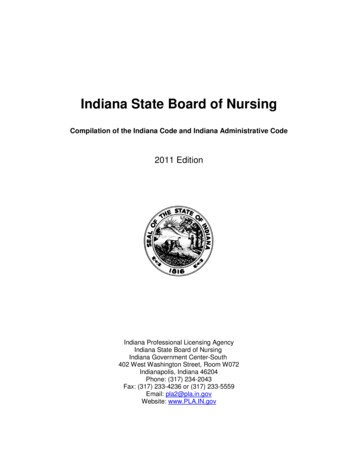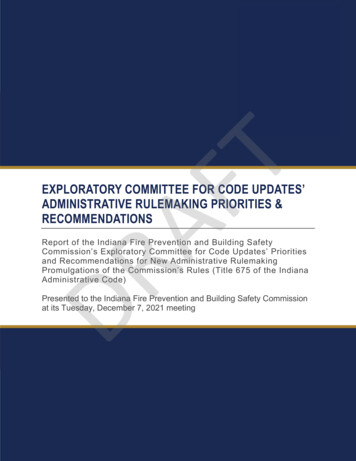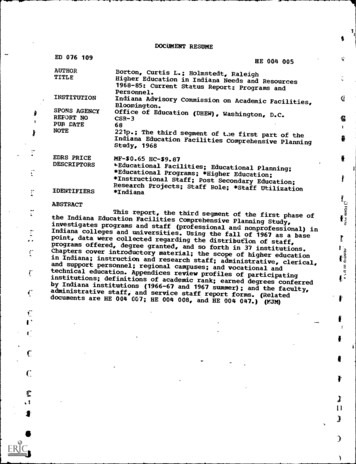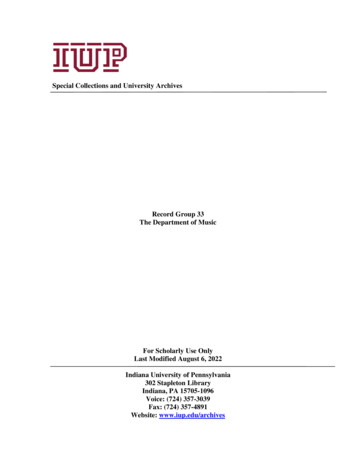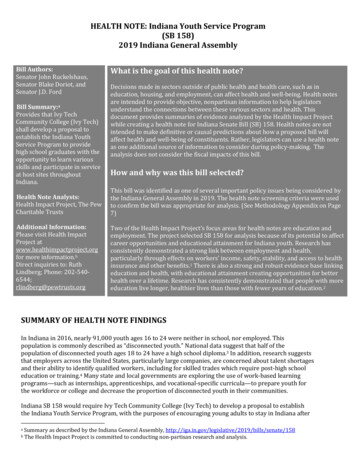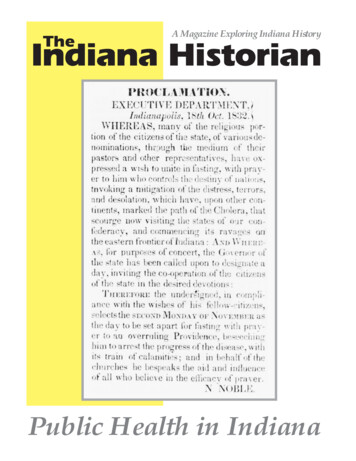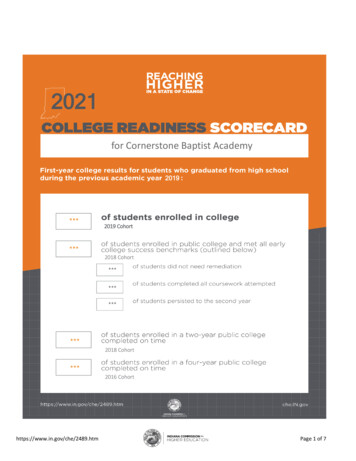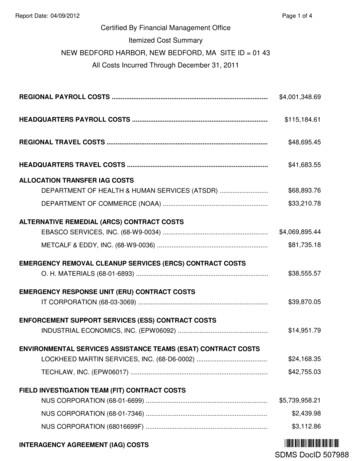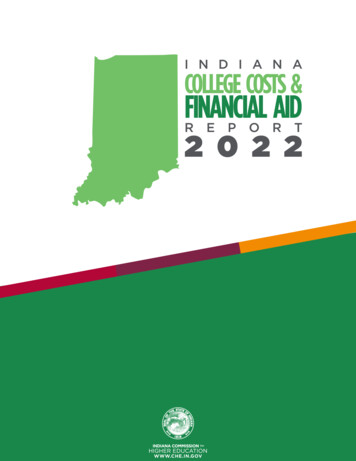
Transcription
I N D I A N ACOLLEGE COSTS &FINANCIAL AIDR E P O R T2 0 2 2WWW.CHE.IN.GOV
INDIANA COLLEGE COSTS AND FINANCIAL AID REPORT 2022 — INTRODUCTIONIndiana focuses on options to keep cost of higher educationwithin reach for all HoosiersWhen we first considered a report featuring the true cost of college inIndiana, we began referring to it as a report on affordability. But what doesaffordability mean, and more importantly — what do Hoosiers think whenthey hear that term?The concept of affordability may seem easy to understand — whethersomeone can buy something depending on its price. The term is subjective,however. What’s affordable to one person is not necessarily affordable toanother person.Recently, the Commission has been working to understand why the collegegoing rate is declining in Indiana. Five years ago, 65 percent of high schoolstudents enrolled in college after graduation. Data in the Commission’s mostrecent College Readiness Report show that rate is currently 59 percent — and it’s going to continue todecline.However, more jobs than ever before and nearly all jobs created in recent years require some level ofeducation beyond a high school diploma. At a time when education is more important than ever, the valueof higher education is being called into question at a rate higher than before. Why?Cost — whether perception or reality — is one of the most important factors for those consideringeducation and training beyond high school. During our research, most Hoosiers interviewed — around 80percent — say they feel “favorable” toward higher education. However, many of those same people believecollege is not the right path for them or it simply isn’t necessary. Both perspectives are overwhelminglyguided by concerns of cost.As shown in this report, the reality of Indiana’s college cost and financial aid landscape is clearly differentthan its perception. While affordability remains a concern, Indiana’s public institutions have kept tuitionincreases low — among the lowest in the nation. In addition, Indiana’s lawmakers have shown a decadeslong commitment to address college costs through sustained and generous financial aid benefits. Our stateis first in the Midwest and fifth in the nation in providing need-based financial aid. Indiana’s early collegepromise program, 21st Century Scholars, has allowed more than 45,000 students to earn a degree withlittle to no debt.In addition to need-based aid, Hoosier students have access to a multitude of public and private grantsand scholarships to make the cost of college more manageable. In fact, most students do not pay the full“sticker” price to go to college.2INDIANA COLLEGE COSTS AND FINANCIAL AID REPORT 2022
INDIANA COLLEGE COSTS AND FINANCIAL AID REPORT 2022 — INTRODUCTIONAlong with concerns of cost, the Commission’s research uncovered that when most individuals hear thewords “higher education,” they think of four-year institutions. A four-year degree is one valued pathway, butit isn’t the only one. Indiana has prioritized expanding the definition of “college” to include an assortment ofpostsecondary programs of varying lengths — and supported this expansion by putting millions in financialaid toward more flexible, shorter-term options.The Workforce Ready Grant, for example, pays for workforce certificates in five of the state’s mostsought-after sectors, including health and life sciences; IT and business services; building and construction,transportation and logistics; and advanced manufacturing. Most of the programs that are part of theWorkforce Ready Grant are short term — usually six months to a year — making them accessible to learnersof all ages.Having the right messengers to inform Hoosier students and families of these opportunities is crucial tochanging the narrative around the value of higher education. Different messengers — such as teachers, schoolcounselors, faith-based organizations, employers and community leaders — resonate with different students andfamilies, and they’re critical to informing the conversation around college costs and financial aid.Education and training beyond high school provides more than a degree or certificate. It’s an investmentthat remains a powerful force to address income disparities, close equity gaps, improve health, driveeconomic growth, promote civic engagement and enhance the quality of life in our Indiana communities.Teresa Lubbers, Indiana Commissioner for Higher EducationINDIANA COLLEGE COSTS AND FINANCIAL AID REPORT 20223
Data-At-A-GlanceINDIANA’S FINANCIAL AIDNEED-BASED AID 385million1stin theMidwest5thin the nation inprovidingneed-basedfinancial aidO F S TAT EFINANCIAL AIDwas availableto Hoosierstudents in2020THE MAJORITY OF INDIANA STUDENTS DO NOTPAY THE FULL PRICE TO GO TO COLLEGEOn average, Hoosier financial aid recipients receivejust over 8,000 in federal and state grants andscholarships per year 8,000INDIANA LAGS IN PUBLIC HIGHER EDUCATIONAPPROPRIATIONSIndiana ranked 41st in the nation for higher educationappropriations by full-time enrollment during fiscalyear 2020More than75%of financial aid recipientss t ay i n I n d i a n a a f t e rgraduation4INDIANA 6,794UNITEDSTATES 8,636INDIANA COLLEGE COSTS AND FINANCIAL AID REPORT 2022
Data-At-A-GlanceINDIANA’S COLLEGE COSTSFIVE-YEAR TUITION RATE INCREASESTuition increases at public, four-year institutions over five years arelower than the national rateUNITEDSTATESINDIANA11%7.5%SELECTFINANCIAL AIDPROGRAMSIndianaoffersgenerousfinancialaid for alllearnersincluding:21st Century ScholarsProgramDEBT IN PERSPECTIVEAn average monthly student loan payment in Indiana is lessthan an average Indiana mortgage or car loan payment 1,000 600 448 333Low-income Hoosiersmust sign up in seventhor eighth grade and fulfillcertain obligations inhigh school and college.The scholarship fullycovers tuition and fees atany public college or anequivalent dollar amountat any private college.Frank O’Bannon GrantMortgageCar LoanBachelor’sDegreeAssociateDegreeAVERAGE DEBT IN 2020 COMPARED TOSURROUNDING STATESThe average student debt for Hoosiers who earned bachelor’sdegrees from public and private universities is 28,521OHIO 30,605MICHIGAN 29,863ILLINOIS 28,552INDIANA 28,521KENTUCKY 28,356TENNESSEE 26,852Low-income Hoosiersmay be eligible for theHigher Education Award(public colleges) orFreedom of Choice grants(private colleges). Thegrant amount is proratedbased on student need.Workforce Ready GrantHoosiers can receiveassistance in coveringthe costs of high-valuecertificate programs.Find out more -and-analyses/INDIANA COLLEGE COSTS AND FINANCIAL AID REPORT 20225
INDIANA COLLEGE COSTS AND FINANCIAL AID REPORT 2022 — KEY TAKEAWAYSKey Takeaways1. Indiana is committed to keeping tuition rate increases flat or at the lowest levelspossible and to providing generous financial aid. Low tuition rates and about 385 million in available state financial aid makes Indiana institutions attractiveoptions for students. Indiana public institutions have kept tuition rates lower thanthe national average for over five years.2. Grants and scholarships help reduce the cost of college and bring college withinreach for many low-income Hoosiers. After grants and scholarships, studentsfrom families with a household income of less than 30,000 pay 30 percent of theaverage cost of college per year. The average total cost of college for Hoosierstudents of public institutions is 11,000 per year.3. Most students receive financial aid, and grants and scholarships are the mostcommon type of aid. Most Indiana students do not pay the full “sticker” price togo to college. On average, Hoosier financial aid recipients receive just over 8,000in grants and scholarships per year.4. Despite Indiana’s commitment to college affordability, sometimes loans may benecessary to cover college costs. Students who take out loans take out about 5,000 each year.Fast Facts6 Indiana ranks fifth in the nation and first in the Midwest in the amount ofneed-based financial aid it gives students. About 57 percent of Indiana bachelor’s earners took out student loans. Among new graduates who took out loans, average student debt isjust under 30,000 for bachelor’s degrees and just under 20,000 forassociate degrees.INDIANA COLLEGE COSTS AND FINANCIAL AID REPORT 2022
INDIANA COLLEGE COSTS AND FINANCIAL AID REPORT 2022 — KEY TAKEAWAYSKey Takeaways5. Not all students graduate with debt— for those who do, the averageis around 25,000. However, theincreased earnings of a degreeoutweigh the total costs of college andmakes monthly student loan paymentsmanageable for most students withinonly a few years of graduation.6. Recent reforms and innovations areimproving affordability. Financialaid changes and programs such asCollegeChoice 529 plans, IncomeDriven Repayment plans and IncomeShare Agreements have given studentsnew financial options and flexibility.Key TermsSticker Price: Costs beforefinancial aid is factored in.Net Price: Costs after grants arefactored in.Cost of Attendance: Tuition andfees plus other costs studentswould typically pay, such asbooks, transportation, and roomand board.Grants: Tend to be based onfinancial need and do not needto be paid back.Scholarships: Tend to be basedon merit and do not need to bepaid back.Loans: Financial aid that is paidback.Need-Based Aid: Aidprovided to students whohave demonstrated financialdifficulties.Merit-Based Aid: Aid awarded tostudents who have distinguishedthemselves academically,artistically, athletically or inanother area.Institutional Aid: Financialaid provided by the student’scollege. Essentially, a discount.INDIANA COLLEGE COSTS AND FINANCIAL AID REPORT 20227
INDIANA COLLEGE COSTS AND FINANCIAL AID REPORT 2022Tuition RatesIndiana is committed to keeping tuitionrate increases flat or at the lowest levelspossible and to providing generousfinancial aid.Since 2009, the Commission for Higher Educationhas set recommended targets for tuition andmandatory fees, with a goal of holding tuition levelsflat or no higher than an inflationary level. Indiana’srecent tuition and mandatory fee increases areamong the lowest in the nation, and annual increaseshave declined significantly in recent years. Over thepast five years, Indiana’s public, four-year institutionshave increased tuition by 7.5 percent, compared tothe national level of 11 percent. Since 2015, tuition andmandatory fees at Indiana’s public institutions haveincreased at roughly the same rate as inflation.Low tuition rate increases make Indiana institutionsattractive options for in-state students and helpmake the cost of going to college more manageable.In addition to keeping tuition rates low, Indianaoffers generous financial aid for all learners withstudents seeing a direct return on investment. Statefinancial aid recipients earn at least two and a halftimes what was invested in them only three yearsafter graduation. Indiana benefits as well with morethan 75 percent of financial aid recipients stayingin the state after graduating from college. Collegegraduates contribute billions of additional dollarsto the state economy compared to high schoolgraduates over the course of a lifetime.Tuition rate increases at Indiana public institutions have been declining from nearly 5 percent in2011 to about 2 percent in 2020.Average annual change in Indiana colleges’tuition and fees5.0%4.5%4.0%3.5%3.0%Avg Tuition & Fees Increase2.5%Annual Inflation2.0%1.5%1.0%0.5%0.0%2011 2012 2013 2014 2015 2016 2017 2018 2019 2020Source: Indiana Commission for Higher Education8INDIANA COLLEGE COSTS AND FINANCIAL AID REPORT 2022
INDIANA COLLEGE COSTS AND FINANCIAL AID REPORT 2022Financial Aid InvestmentIndiana’s financial aid investment has increased by 23 percent in the past five years.Indiana Financial Aid Expenditures 450,000,000 400,000,000 350,000,000 300,000,000 250,000,000 200,000,000 150,000,000 100,000,000 50,000,000 FY 12FY 13FY 14FY 15FY 16FY 17FY 18FY 19FY 20FY 21Source: Indiana State Budget AgencyIndiana’s overall financial aid expenditures have increased over time — growing from roughly 311 million in2016 to around 385 million in 2020. The state’s efforts to continue increasing its financial aid expendituresand its commitment to offer a variety of financial aid programs to students of all ages help to lower theoverall cost of college.Indiana’s premier need-based financial aid option is its early college promise program, 21st CenturyScholars. The program provides up to four years of undergraduate tuition to income-eligible students atparticipating colleges or universities in Indiana. More than 45,000 Scholars have earned a degree withtuition and fees fully covered since 1990.The Workforce Ready Grant is part of Indiana’s non-need-based state financial aid. The Workforce ReadyGrant provides tuition-free certificates in five of the state’s most sought-after sectors, including health andlife sciences; IT and business services; building and construction, transportation and logistics; and advancedmanufacturing. Since its creation, nearly 60,000 Hoosiers have enrolled in a high-demand certificateprogram, and nearly 32,000 Hoosiers have completed a certificate for free, leading to an almost 7,000annual wage gain.INDIANA COLLEGE COSTS AND FINANCIAL AID REPORT 20229
INDIANA COLLEGE COSTS AND FINANCIAL AID REPORT 2022State AppropriationsCompared to the nation, Indiana lags in public highereducation appropriations. According to the StateHigher Education Finance Report, Indiana ranked41st in the nation for higher education appropriationsby full-time enrollment during fiscal year 2020. Thenational average of appropriations is nearly 9,000while Indiana’s is just above 7,000.During fiscal years 2014 and 2015 higher educationmade up 13 percent of Indiana’s General FundAppropriations. In the current biennium (fiscalyears 2022 and 2023), higher education makes up11 percent. Operations makes up the largest portionof appropriations with state financial aid support asanother substantial allocation.As generous as Indiana’s appropriations have been to financial aid, higher education’s share of thestate budget has decreased over the decade.Higher Education's Share of Indiana's General Source: Indiana State Budget Agency10INDIANA COLLEGE COSTS AND FINANCIAL AID REPORT 2022FY22-FY23
INDIANA COLLEGE COSTS AND FINANCIAL AID REPORT 2022Financial Aid Impact for Low-IncomeStudentsGrants and scholarships help bring college within reachfor many low-income Hoosiers.Financial aid comes in many different forms. The most common aregrants, scholarships and loans. Grants and scholarships do not need tobe paid back, whereas loans do. Financial aid is provided by federal andstate governments, colleges (known as institutional aid) and by privateorganizations.The total cost of attendance includes tuition and fees along withexpenses for books, room and board, transportation and other needs.Some or all of the cost of attendance is often offset by financialaid. The amount that students pay, after subtracting out grants andscholarships, is known as the net price.The net price is the institution’s cost of attendance minus any grantsand scholarships. It is generally more informative than the “stickerprice.”Select FederalFinancial AidProgramsPell GrantSimilar to the FrankO’Bannon grants, thisfederal grant is availableto low-income studentson a prorated basis.Federal Direct LoanProgramThis program aims toprovide low-interestloans for students andparents.Indiana’s need-based aid programs help bring college within reachfor many low-income Hoosier students and families. After grants andscholarships, students from families with a household income of less than 30,000 pay 30 percent of the averagecost of college per year.On average, students from families making less than 30,000 pay 11,270 less per year in college coststhan students from families making more than 110,000.Typical Annual Net Price (After Financial Aid) atIndiana Public Four-Year Colleges 20,000 18,000 16,000 14,000 12,000 10,000 8,000 6,000 4,000 2,000 0 17,884 6,614Family Income 0- 30,000Family Income over 110,000Source: ICHE analysis of information provided by U.S. Department of Education, National Center of Education Statistics, IPEDSINDIANA COLLEGE COSTS AND FINANCIAL AID REPORT 202211
INDIANA COLLEGE COSTS AND FINANCIAL AID REPORT 2022Types of Financial AidMost students receive financial aid, andgrants and scholarships are the mostcommon type of aid.much as state and federal aid combined. Institutionalgrants and scholarships can be difficult to estimatesince those are essentially discounts and oftencome from distinct funds, donations or specializedendowments spread across the college.Most Indiana students do not pay the full “sticker”price to go to college. The majority of Hoosierstudents receive some form of financial assistancesuch as a grant, scholarship and/or loan to pay forcollege.Filing the Free Application for Federal Student Aid(FAFSA) remains the number one way for studentsThe State of Indiana makes available about 385million, and the U.S. Department of Educationdistributes roughly 560 million to Hoosierlearners. In addition to state and federal grants andscholarships, students receive institutional financialaid awarded by Indiana colleges and universities. Bysome estimates, those grants and scholarships are asto take advantage of the available federal, state andeven some institutional aid. According to recent datafrom the National College Attainment Network,Indiana’s high school class of 2021 could’ve takenadvantage of upwards of 65 million in federal PellGrants by completing the FAFSA. For many ofIndiana’s financial aid, including the Workforce ReadyGrant and 21st Century Scholars program, having anupdated FAFSA on file is required.On average, Hoosier financial aid recipients receive just over 8,000 in total grant andscholarship aid per year.2- Year4- yearGrants and scholarships by institution, 2019-2020Percentreceiving grantsand scholarships(federal, state orinstitutional)Averageamount ofgrant andscholarshipaid (federal state institutional)Percentreceivingfederalgrants andscholarshipsPercentreceivingstate grants andscholarshipsBall State UniversityIndiana State UniversityIndiana University-BloomingtonIndiana University-EastIndiana University-KokomoIndiana University-NorthwestIndiana University-Purdue University-IndianapolisIndiana University-South BendIndiana University-SoutheastPurdue University Fort WaynePurdue University NorthwestPurdue University-Main CampusUniversity of Southern Indiana76%80%69%78%89%73%87%91%72%93%62%42%95% 12,049 9,714 11,213 8,284 5,781 7,799 10,327 7,123 7,544 7,210 7,736 10,778 %77%49%25%80%27%40%64%Ivy Tech Community College65% 5,71755%43%12%Vincennes University86% 7,07154%52%34%Source: U.S. Department of Education, National Center for Education Statistics, IPEDS12INDIANA COLLEGE COSTS AND FINANCIAL AID REPORT 2022
INDIANA COLLEGE COSTS AND FINANCIAL AID REPORT 2022Total College CostsGrants and scholarships reduce the costof college by thousands of dollars forstudents and families.Education Award; and the Lilly EndowmentCommunity Scholarship, funded through the privateorganization Lilly Endowment. Many communitiesand organizations across the state also offerscholarships.The eligibility requirements for grants andscholarships are typically more specific than thosefor loans. Most grants and scholarships requirestudents to show financial need (known as needbased aid) through filing the FAFSA or throughacademic accomplishments (known as merit-basedaid). Athletic scholarships are rare; about 1 percent ofcollege students have a sports-related scholarship.Both federal and state grants reduce the total annualcost of college by thousands of dollars. The totalcost of college includes tuition, fees, books, otherexpenses, and room and board. This total can varyby students’ experiences such as living on campus,book prices and more.Some of the most awarded grants include federalPell Grants; state grants such as the 21st CenturyScholars program and the Frank O’Bannon Grant,which include the Freedom of Choice and HigherOn average, the total cost of college for Hoosier students at public institutions is 11,000 per year.2- Year4- yearTotal costs before and after grants and scholarships (excluding loans), 2019-2020Tuition, Fees,Books and OtherExpensesRoom andBoardTotalStickerPriceAverage Costafter Grants andScholarships, butbefore Loans 14,204 13,046 14,981 11,287 12,721 12,721 13,516 11,287 11,287 13,479 13,486 12,752 12,785 10,796 11,016 11,206 10,382 8,040 8,040 10,152 8,958 10,382 8,765 7,821 10,030 9,514 25,000 24,062 26,187 21,669 20,761 20,761 23,668 20,245 21,669 22,244 21,307 22,782 22,299 13,195 12,903 13,191 8,675 10,066 5,453 12,345 9,446 10,421 12,071 10,279 12,294 13,958 9,777 6,848 16,625 7,208 10,669 10,590 21,259 10,824Ball State UniversityIndiana State UniversityIndiana University-BloomingtonIndiana University-EastIndiana University-KokomoIndiana University-NorthwestIndiana University-Purdue University-IndianapolisIndiana University-South BendIndiana University-SoutheastPurdue University Fort WaynePurdue University NorthwestPurdue University-Main CampusUniversity of Southern IndianaIvy Tech Community CollegeVincennes UniversitySource: U.S. Department of Education, National Center for Education Statistics, IPEDSINDIANA COLLEGE COSTS AND FINANCIAL AID REPORT 202213
INDIANA COLLEGE COSTS AND FINANCIAL AID REPORT 2022Student LoansDespite Indiana’s commitment to collegeaffordability, sometimes loans may benecessary to cover college costs.Student loans are typically provided by the U.S.Department of Education (though may be servicedby other entities) or by private lenders. More thanhalf (57 percent) of all Indiana graduates havestudent debt. The average monthly loan repaymentis 448 for bachelor’s degree earners and 333for associate degree earners. This compares to theaverage Indiana home mortgage of about 1,000, anaverage monthly payment of nearly 600 for a newvehicle and an average monthly payment of over 400 for used vehicles.There are three major federal loan programs availableto undergraduate students. Subsidized loans areavailable to students with financial need. Studentsdo not accrue interest on subsidized loans while theyare in school. Unsubsidized loans are available tostudents regardless of financial need. Parent PLUSloans are available to parents of undergraduatestudents. For more information, visit studentaid.gov.There are many types of private loans. Private loansgenerally require good credit and may offer fewerrelief options than federal loans. See page 18 foran overview of private lending programs known asIncome Share Agreements.Students who take out loans take out about 5,000 each year.2- Year4- yearFederal student loans by institution, 2019-2020Ball State UniversityIndiana State UniversityIndiana University-BloomingtonIndiana University-EastIndiana University-KokomoIndiana University-NorthwestIndiana University-Purdue University-IndianapolisIndiana University-South BendIndiana University-SoutheastPercent of2019-20 studentsreceiving federalstudent loans61%65%34%37%39%34%41%38%40%Average amount of federalstudent loans taken out in2019-20 5,521 6,555 5,033 4,617 4,677 4,898 4,764 4,740 4,821Purdue University Fort WaynePurdue University NorthwestPurdue University-Main CampusUniversity of Southern Indiana44%39%28%52% 4,631 5,049 5,077 5,108Ivy Tech Community College18% 3,978Vincennes University54% 6,932Sources: US Department of Education, National Center for Education Statistics, IPEDS; e-student-loan-payment14INDIANA COLLEGE COSTS AND FINANCIAL AID REPORT 2022
INDIANA COLLEGE COSTS AND FINANCIAL AID REPORT 2022Average Student DebtNot all students graduate with debt —for those who do, the average is around 25,000.When comparing all public and private collegestudents who earned bachelor’s degrees in 2020,Indiana has the 28th highest level of overall studentdebt (an average of 28,521) and the 21st highestpercentage of graduates with debt (57 percent) inthe nation.While Indiana’s average student debt has changedlittle since 2015, the percentage of graduates withdebt has decreased. Five years ago, Indiana had the23rd highest percentage of graduates with debt (61percent of all bachelor’s degrees earners).years to graduate. Nationwide, about 47 percentof new associate graduates have debt, and thoseborrowers owe an average of 19,600. By using aweighted average, the Commission has estimatedbetween two- and four-year degrees, the typicalindividual who graduates with student debt hasabout 25,000.However, the increased earnings of a degree morethan exceed the total costs of college — debtincluded — for most students within only a few yearsof graduation. According to the Commission’s 2020College Value Report, five years after graduation,the median salary of associate degree holders is 36,320. The median salary of bachelor’s degreeholders after five years is 46,153. However, salariesrange greatly by program of study.Debt for associate and certificate programs varieswidely; many students might take one, two or severalThe average overall student debt for those who earned bachelor’s degrees frompublic and private universities is 28,521.Bachelor’sDegreeDebt 30,605NEIGHBORING STUDENT DEBTStateAverage DebtOhio 30,605Michigan 29,863Illinois 28.552Indiana 28,521Kentucky 28,356Tennessee 26,852 28,356Source: TICAS Student Debt and the Class of 2020 ReportINDIANA COLLEGE COSTS AND FINANCIAL AID REPORT 202215
INDIANA COLLEGE COSTS AND FINANCIAL AID REPORT 2022Statewide Reforms & InnovationsReforms and recent innovations areimproving affordability.Indiana’s outcomes-based funding formula places alarge premium on on-time completion.For nearly two decades, state policymakers haveembraced an outcomes-based funding formula forpublic institutions by utilizing a portion of the state’spublic university operating funds — 7 percent or 86million — for outcomes-based funding. This fundingmodel has evolved over time, emphasizing the resultsthat higher education must provide to its studentsand the state to ensure student success, personalprosperity and economic mobility.The formula includes an on-time graduation ratemetric which recognizes the value of institutionsincreasing students’ likelihood of success bygraduating on-time while reducing the overall costper degree. Every year students extend the termof their college degree program decreases theirchances of graduating. Extended time also leads tounnecessary cost. Two additional years in collegecan cost 50,000 or more in lost wages, tuition andrelated costs, making the most cost-effective degreean on-time degree. This is even more critical forfinancial aid recipients, whose support is limited tofour years (or eight semesters).21st Century Scholars reforms strengthen programand student success.Indiana’s financial aid programs have seen significantreforms and results over the past decade, particularlythe 21st Century Scholars program, which started in1990. To help students better prepare for the rigorsof education beyond high school, Indiana createdMost high schoolers in the Scholars program complete the Scholars Success Program.70% of High School Scholars Completethe Required Scholars Success Program81%85%85%77%9th SSP79%80%70%9th - 10th SSP201773%73%9th - 11th SSP201868%70%9th - 12th SSP2019Source: Indiana Commission for Higher Education1669%INDIANA COLLEGE COSTS AND FINANCIAL AID REPORT 2022
INDIANA COLLEGE COSTS AND FINANCIAL AID REPORT 2022Statewide Reforms & Innovationsthe Scholar Success Program in 2011 — a series of12 required activities Scholars must complete eachyear of high school. Scholars must also maintain aminimum high school GPA of 2.5 and earn a Core 40high school diploma.College Scholars are required to complete theCollege Scholar Success Program. The program wascreated in 2018 and focuses on first-year experiencesand integrating career relevance and preparationthrough internships and work-based learning. Aspart of the program, Scholars must earn at least 30college credits each year which keeps them on trackto graduate on time and not incur additional debt.Additionally, institutions offer campus-specificincentives such as summer bridge programs,supplemental scholarships, fee waivers, first-yearexperiences/learning communities and designatedcampus contacts specifically for 21st CenturyScholars. Learn More Indiana provides a free 21stCentury Scholars College Incentives Guide.Indiana University Bloomington and PurdueUniversity West Lafayette offer supplementalscholarships that cover expenses the 21st CenturyScholarship does not such as housing. Both awardsvary by each student’s financial need as determinedby their FAFSA.IU’s 21st Century Scholarship Covenant awardprovides additional funding to assist with room andboard, books and supplies. In addition to receivingfinancial assistance, students who are awardedPurdue Promise are assigned a Purdue PromiseCoach who serves as a mentor throughout their timePurdue. They are also required to take first-year andsenior-year courses that help students transitionfrom high school to college and then be successfulafter graduation.As these financial aid reforms have come intoplace, more Scholars have gone to college, morehave persisted and more have graduated on time.For more information on the 21st Century Scholarsprogram, see the Commission’s recent report,Indiana’s Promise: A Report on the 21st CenturyScholars Program.Debt letters increase students’ understanding offinances and lower borrowing.In 2015, the General As
INDIANA'S COLLEGE COSTS FIVE-YEAR TUITION RATE INCREASES Tuition increases at public, four-year institutions over five years are lower than the national rate UNITED STATES 7.5% 11% . INDIANA COLLEGE COSTS AND FINANCIAL AID REPORT 2022 — KE TAKEAWAYS INDIANA COLLEGE COSTS AND FINANCIAL AID REPORT 2022 — KE TAKEAWAYS. Key Terms.
